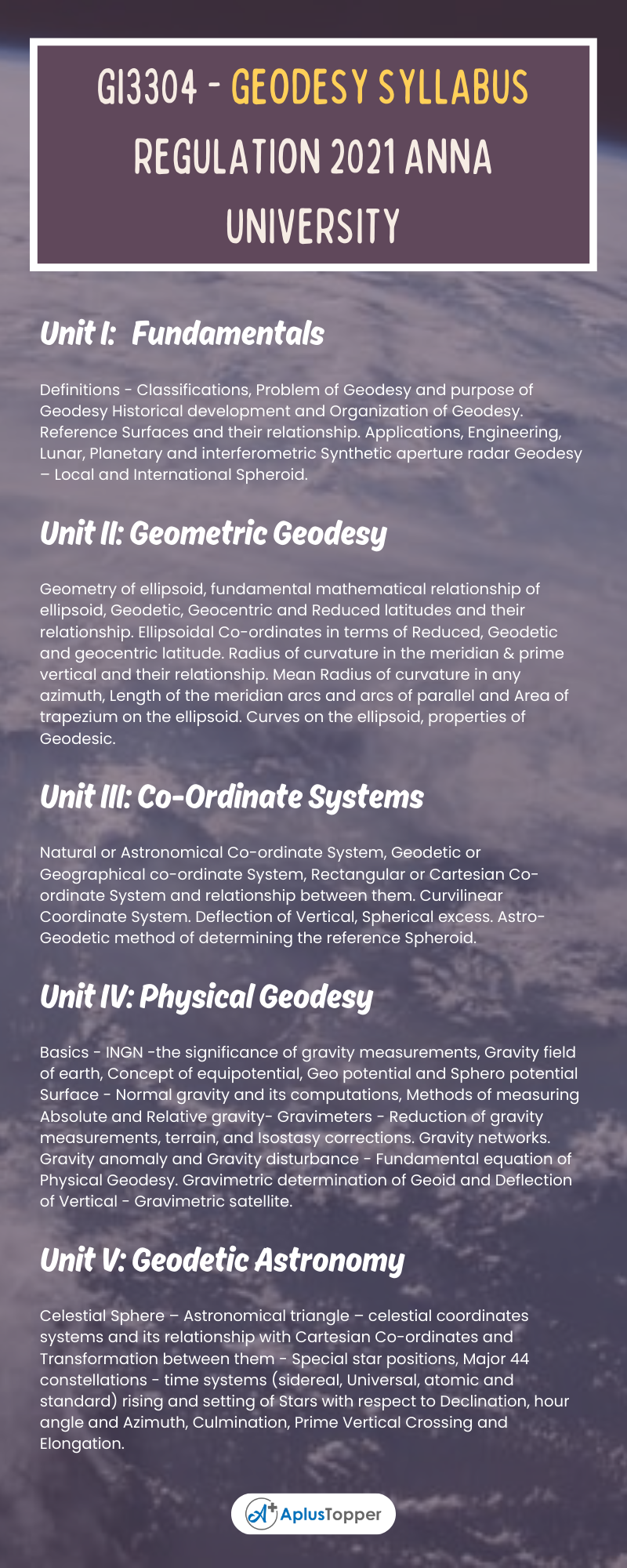GI3304 Subject code deals with the semester III Subject Geodesy syllabus of Anna University 2021 Revised regulation syllabus of B.E Geo Informatics Engineering. It is provided based on the student’s point of view to prepare well for academic examinations.
In this article, we would like to discuss the GI3304 – Geodesy Syllabus. To get good marks in the academic examinations, need a certain guide to assist you with the chapter-wise syllabus right? We include the chapter-wise syllabus for students, to assist them simply. A clear picture of the syllabus in your mind helps to understand the topics from every unit or chapter.
Then you will get an idea of where to begin from the whole syllabus by separating the topics easy from hard topics. Having command of the subject syllabus makes it easy to revise the syllabus for examination and helps you to excel in academics. The following article will give you sufficient information regarding the syllabus. Don’t forget to share it with your friends.
If you want to know more about the syllabus of B.E Geo-Informatics Engineering connected to affiliated institutions under a four-year undergraduate degree program. We provide you with a detailed Year-wise, semester-wise, and Subject-wise syllabus in the following link B.E Geo-Informatics Engineering Syllabus Anna University, Regulation 2021. Hoping this information is useful to you.
Aim Of Concept:
- To understand the geometry of the earth, Gravity, and its relationship with nature.
GI3304- Geodesy Syllabus
Unit I: Fundamentals
Definitions – Classifications, Problem of Geodesy and purpose of Geodesy Historical development and Organization of Geodesy. Reference Surfaces and their relationship. Applications, Engineering, Lunar, Planetary and interferometric Synthetic aperture radar Geodesy – Local and International Spheroid.
Unit II: Geometric Geodesy
Geometry of ellipsoid, fundamental mathematical relationship of ellipsoid, Geodetic, Geocentric and Reduced latitudes and their relationship. Ellipsoidal Co-ordinates in terms of Reduced, Geodetic and geocentric latitude. Radius of curvature in the meridian & prime vertical and their relationship. Mean Radius of curvature in any azimuth, Length of the meridian arcs and arcs of parallel and Area of trapezium on the ellipsoid. Curves on the ellipsoid, properties of Geodesic.
Unit III: Co-Ordinate Systems
Natural or Astronomical Co-ordinate System, Geodetic or Geographical co-ordinate System, Rectangular or Cartesian Co-ordinate System and relationship between them. Curvilinear Coordinate System. Deflection of Vertical, Spherical excess. Astro-Geodetic method of determining the reference Spheroid.
Unit IV: Physical Geodesy
Basics – INGN -the significance of gravity measurements, Gravity field of earth, Concept of equipotential, Geo potential and Sphero potential Surface – Normal gravity and its computations, Methods of measuring Absolute and Relative gravity- Gravimeters – Reduction of gravity measurements, terrain, and Isostasy corrections. Gravity networks. Gravity anomaly and Gravity disturbance – Fundamental equation of Physical Geodesy. Gravimetric determination of Geoid and Deflection of Vertical – Gravimetric satellite.

Unit V: Geodetic Astronomy
Celestial Sphere – Astronomical triangle – celestial coordinates systems and its relationship with Cartesian Co-ordinates and Transformation between them – Special star positions, Major 44 constellations – time systems (sidereal, Universal, atomic and standard) rising and setting of Stars with respect to Declination, hour angle and Azimuth, Culmination, Prime Vertical Crossing and Elongation.
Textbooks:
- Wolfgang Torge, Geodesy, Walter De Gruyter Inc., Berlin, 2015 2nd edition.
- Guy Bomford II Geodesy II Nabu Press, 2015, ISBN 1172029091.
References:
- PetrVanicek and Edward J. Krakiwsky, Geodesy: The concepts, North-Holland Publications Co., Amsterdam, 2014 2nd edition.
- Tom Herring, Geodesy Elsevier,2009, ISBN: 0444534601
- Schwarze, V.S. Geodesy: The challenge of the 3rd millennium, Springer verlag, and 2003.
- James R.Smith, Introduction to Geodesy, John wiley & Sons Inc. 1997
Related Posts On Semester – III:
- MA3302 – Transforms and Statistics
- GI3301 – Spatial Database Management system
- GI3302 – Surveying
- GI3303 – Remote Sensing
- GI3391 – Photogrammetry
